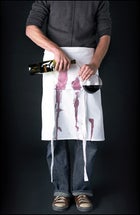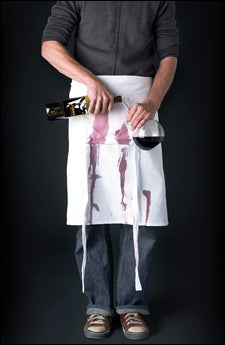AS LONG AS I've been friends with Tim “the Nose” Wanner, a wine importer in Boulder, Colorado, he and I have dreamed of making our own vino. Why? Because we like the taste. Because we savor that mellow, warm-in-the-belly buzz. Because, during six years of cellar tours together, we have developed strong opinions about what constitutes the good stuff┬Ś12.5 percent alcohol, subdued fruit flavors, no cutesy animals on the label┬Śbut can appreciate everything from plonk to P├ętrus.
Wine-making

╠ř
And we wanted to spread the love. “Gotta make our own wine!” we'd often shout. And then we'd sober up.
Anyone can ferment mail-order grapes in a trash can out back, but making decent wine is difficult. Most grapes must be picked by hand in late September or early October; de-stemmed, crushed, and fermented in a manic couple of weeks; blended by shaman-like consultants; and then put away in dark cellars for years. The Nose and I always figured it'd be easier to assemble our own 5-Series in a borrowed BMW factory.
Or would it? We started working Tim's European connections, and on May 20, just a week after my first call, one of the Nose's Italian friends put me in touch with Francesco Illy.
The 57-year-old former vice president of Illy, the family coffee dynasty, Francesco owns a small estate in Montalcino, Tuscany, and had a reputation for nutty-professor eccentricity: a big thinker with a wallet to match. His pastimes include creating highly detailed, mural-size landscape photographs and then shrinking them down to eight-by-tens, thus rendering the detail invisible to the naked eye. His latest business venture is creating a combination radio/espresso machine, called Good News, that can play sunny headlines while you pull a shot.
His 133-acre winery, Le Ripi, is something of a hobby. Six years ago, Francesco began producing brunello di Montalcino┬Śthe 100 percent sangiovese varietal that is the pride of Italy, second in esteem only to the powerful barolo┬Śone of which is called Lupi e Sirene. The label features topless mermaids and wolves with bright-red hard-ons.
Francesco was not just excited about collaboration; he thought our interest in making wine was a “sign of destiny.” While we wouldn't be able to roll up our cuffs and stomp some grapes, he offered to let us come over and blend a wine. He told me he had long fantasized about taking sangiovese from two or three of his best barrels and blending them together to make a new brunello.
“Everything has a father and a mother, and you can be the father of this new wine,” he said. “Tim can be the mother.”
We booked our tickets and set a straightforward, blindly ambitious goal: We'd make a brunello that The Wine Advocate magazine┬Ścreator of the now ubiquitous 100-point wine-ranking scale┬Śwould score at a very respectable 90 points or better.
MAKING WINE THESE DAYS often involves industrial processes you're more likely to associate with food products like Cheez Whiz. Wines can be made to feel soft in the mouth by the addition of fining agents such as egg whites; tinted with a concentrate called Mega Purple; and fermented with genetically modified “designer” yeasts. Some popular wines arrive in┬Śand depart from┬Śthe States not in bottles but sloshing around in the enormous holds of tanker ships, and an estimated one-fifth of all California wine, including some very good stuff, is initially so boozy that it's sent to an industrial park in Santa Rosa, where it's spun around inside ConeTech's de-alcoholizing centrifuges to reach the desired alcohol content.
Knowing all this, it feels as if we're driving back in time as we steer our Alfa Romeo rental into Francesco's idyllic estate. Le Ripi is a stone house that sits at the end of a lonely, ridgetop dirt road, roughly ten miles from the walled city of Montalcino. A light-green patchwork of vines drapes along a south-facing slope, down sandy ravines to the bouldery Orcia River. Across the valley, ancient castles poke through wild forests.
“A gentle breeze blows, carrying the scent of wild asparagus, sage, and mint,” I scribble in my notebook┬Śthe first sign, I'll later realize, that I've begun to drink too deeply of the Tuscan Kool-Aid.
“Welcome,” says Lisa, who oversees Mastrojanni, a neighboring winery owned by the family corporation. “Glad you decided to visit us.”
Due to navigational difficulties, we are┬Ścough, cough┬Śfour hours late. But no matter. It soon becomes clear that we've entered a parallel universe where all the news is sunny, some of the details are imperceptible, and the space-time continuum warps around the eccentric Francesco's every move. Right now, he's otherwise disposed, so Lisa, a slender brunette who speaks loud English, keeps us occupied with a tour of Mastrojanni. The tidy, medium-small operation has been run by the same old-school winemaker since the early nineties. The tour is long and rambling, and by the time we start tasting its latest brunellos┬Śone of which The Wine Advocate recently gave 91 points┬Śwe're beginning to wonder if we'll see Francesco at all.
And then he appears, springing into the cellar, speaking ecstatically about a near-crash that almost happened when he was shooting photographs of the Orcia River from a friend's helicopter. He's sporting wispy facial hair that's somewhere between stubble and a proper beard, a gray ponytail, and what we'll later realize is his standard uniform: jeans, a butter-yellow polo shirt, and a salmon-colored blazer.
“Hello,” he says in English, his distracted eyes giving the distinct impression that he has no idea who we are. And then he leaves.
That night, the feeling of unfamiliarity continues. All we know is that we're supposed to have dinner together. When we meet at Mastrojanni, Francesco introduces himself not with a “Ciao” but by handing us bottles of brunello and saying, “We might drink a little, so we'll take the back roads.” Then we all pile into his purple Range Rover.
Chatting over carpaccio and pasta with wild boar sauce at one of Francesco's favorite restaurants proves no less disorienting. He jumps from topic to topic, one moment using his iPhone's Google Maps to try and find where he moored his 56-foot yacht (was it Greece or Croatia?), the next railing against the fascist absurdity of Italy's organic-farming regulations. According to him, regulators would rather he let his whole vineyard be gobbled to death by red spiders than use one cup of chemical pesticide.
When the conversation finally turns to vino rosso, however, he demonstrates why he's a serious player in the exalted business of making brunellos. He wants, he says, to make a brunello of the future.
BRUNELLO, WHICH IS produced only in Tuscany's Montalcino region, was first created in the late 19th century, when a former soldier began experimenting with the sangiovese grosso, a grape that was small and hardy and soon called brunello, or “little brown one.” Ever since, the grape has been the foundation of one of the most elegant and expensive wines in Italy. But despite brunello's prestige, the region's vineyards have experienced several ups and downs during the 20th century. Stability arrived in the seventies, when rich guys like Francesco started buying up the small estates. And while there are now exactly 202 winemakers in this tiny region┬Śit produces about 540,000 cases a year, roughly one-tenth as much as a single large industrial winery┬Śnone is quite like Francesco.
Whereas most winemakers ferment their grapes in oak or steel vats, he built a huge tank out of thick glass so he could watch the fermentation and perhaps figure out a better way to mix the grapes. And for almost eight years he's been testing, at great expense, a strategy he's dubbed the Bonsai Method. Ignoring hundreds of years of farm-won wisdom, he has planted roughly twice as many grapes per acre as normal, so that the vines have to fight each other for nutrients in the soil. Then he snips every third bunch, leaving only the sturdiest grapes to ripen.
“Plants,” he explains, “make better wines in a good stress situation.”
True enough, but we've never seen stress like that. There's a thin line between genius and madness, as they say, and we aren't sure where Francesco has landed.
“His brunello was exciting,” the Nose tells me later, when Francesco is away, “but it hasn't found its voice. It needs to age.”
I agree, but there's hope. Around midnight, with the restaurant long empty, Francesco and the Nose and I smoking cigars, Francesco finally asks, “So, what do you want to do in Montalcino?”
He has never once said our names, has never said anything about his blending offer. Now he's asking us what we hope to do while we're in town! Worried that he's forgotten we're part of his “destiny,” I stammer, “Uh, we'd like to blend a brunello, like we talked about on the phone.”
“OK,” he replies, and then he does us one better, suggesting that the day after tomorrow we try blending his untested wine and some of Mastrojanni's highly praised stuff. We're relieved, and we spend the next day and a half sampling dozens of producers' brunellos and familiarizing ourselves with the local winescape.
AT THE APPOINTED TIME, we arrive at Francesco's spacious stone manor, feeling excited. We're quickly introduced to his girlfriend, Roberta, and a man with wavy gray hair, Maurizio, whom Francesco describes simply as “my consultant.”
While you might imagine that blending would involve all those horrid techniques from chemistry class, it doesn't require a single titration or pH test, just aesthetic instinct and occasional measuring. Michael Silacci, the virtuosic winemaker at California's esteemed Opus One, says he's not sure he's a master blender even now. “All I know is that I can keep more balls in the air.” After more than a decade's worth of experience, he and his team can blend juice from as many as five different grapes, like painters creating a beautiful cerulean blue from a rainbow palette. He mixes and matches for weeks, employing half a dozen colleagues to try different formulations.
We have no experience. And only one afternoon. After 45 minutes in the cellar, tasting from some two dozen barrels numbered according to year and vineyard plot, we choose our main ingredients: 12 favorite 2006 sangioveses. Then we head upstairs to a long wooden table in the living room. As we wash a graduated cylinder and a box of new glasses┬Śthe only tools necessary for blending┬ŚMaurizio methodically sets up the bottles. Mastrojannis line one side of the table, Le Ripis the other, the vintage, barrel number, and other details noted on their masking-tape labels.
The Nose makes the first fateful experiment, combining equal parts of our two favorite bottles┬Ś38, with its “sweet cherry notes,” and 3, with its “near complete package.” He swirls, gargles, and…it tastes god┬şawful. The next few blends are equally repugnant. Using reverse logic, the Nose tries mixing our two least favorites, but this too ends up in the spittoon. My efforts are no better, prompting over-the-top scribblings like “toasted raisins in a soup of roofing tar.”
Francesco grows impatient; Maurizio says nothing. Only later will we learn that he should have been saying quite a bit, that he's a bona fide blending superstar, making wines on multiple continents for Mario Batali and the Cinzano family, among others. Had we asked his advice, he surely would have told us that the first rule of blending is to find a good wine to function as the base and then slowly add small amounts of other wines, as little as one-tenth of a percent at a time, to correct or enhance it.
Instead, we continue slopping together great quantities, dulling our palates with repeated mistakes. Tired of watching us flounder, Maurizio finally samples one of my attempts. “They're not complementary,” he observes. Then he makes a blend and passes it around as an example.
Sure enough, it's humblingly good. And I have no idea how he did it. If I add wine with a bit of peppery bite, the blend becomes wonderfully peppery, but it also turns rough and tannic. If I add wine with a nice soft texture, it becomes velvety smooth, but the fruitiness vanishes.
By early afternoon, Maurizio is long gone, Francesco is asleep on the couch, and Roberta is reading a magazine in the other room. At least 40 glasses of wine have passed through my mouth and only the purpleness of my prose is improving. A sample of my tasting notes: “shellacked with melted toffee,” “licorice dipped in cocoa powder,” “scent of wet tobacco.” I need a break.
The Nose, however, remains unfazed┬Śand has become preoccupied with finding the perfect balance of two different wines, before adding drips of a third. Just as I'm starting to go cross-eyed, he blurts out “This is it!” and holds up his latest creation┬Ś80 percent from barrel 4, 15 percent from 41, 5 percent from 49. “I think it's better than Maurizio's.”
I sample it. “I think it's a 90-point wine!”
BACK HOME, WE SETTLE on a name┬ŚFurbo (“Wise Guys”)┬Śand hire a designer friend, who makes a tough-guy label featuring Al Capone puffing a stogie. Our unmarked case of black bottles slips past customs, uninspected, three months later.
A few weeks after that, Antonio Galloni, The Wine Advocate's taster of Italian wines, agrees to try Furbo. On October 15, I drop off a bottle at his apartment on Manhattan's Upper East Side, leaving our dream in the responsible hands of the big critic's babysitter.
Three days later, he e-mails his observations. The cons are hard to swallow: “This is a lightweight style of wine that doesn't have the stuffing I expect from a 2006 Tuscan red, especially a wine from Montalcino,” he writes. The finish was “abrupt” and “lacked depth.”
Any words of praise? “Good color.”
Score: 84 points, a C for wine in general and a D for any wine from Montalcino. An $11 bottle of Yellow Tail the Reserve Shiraz, by comparison, got 87 points.
“Thrown under the bus!” howls the Nose after I read him Galloni's assessment. “Why doesn't he tell us what he really thinks? Do we have to mention our names in the story?”
I'm a bit crestfallen, too. But then I remember that, in a cardboard box under my bed, I have 11 bottles that quite possibly constitute the rarest booze in New York. They're about 12.5 percent alcohol, have a macho label, and contain fruit flavors so mellow, one could even say they lack “stuffing.” Cork-popping party! Time to spread the love.


